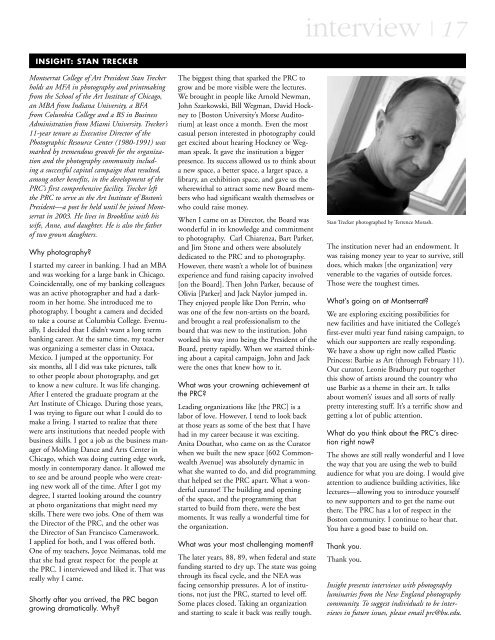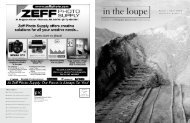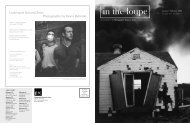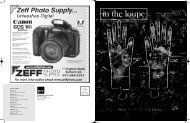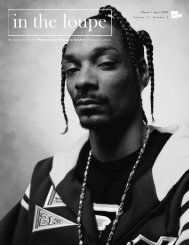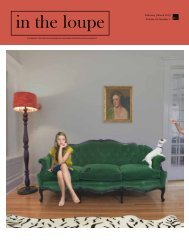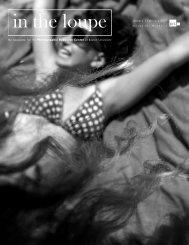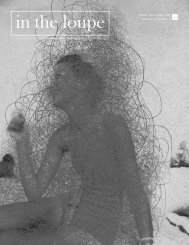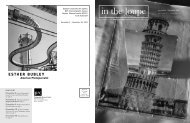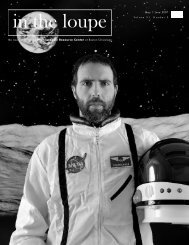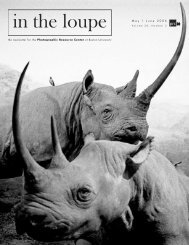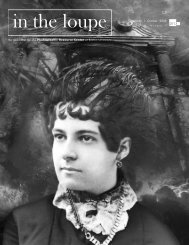January | February 2006 - Boston Photography Focus
January | February 2006 - Boston Photography Focus
January | February 2006 - Boston Photography Focus
You also want an ePaper? Increase the reach of your titles
YUMPU automatically turns print PDFs into web optimized ePapers that Google loves.
interview | 17<br />
INSIGHT: STAN TRECKER<br />
Montserrat College of Art President Stan Trecker<br />
holds an MFA in photography and printmaking<br />
from the School of the Art Institute of Chicago,<br />
an MBA from Indiana University, a BFA<br />
from Columbia College and a BS in Business<br />
Administration from Miami University. Trecker’s<br />
11-year tenure as Executive Director of the<br />
Photographic Resource Center (1980-1991) was<br />
marked by tremendous growth for the organization<br />
and the photography community including<br />
a successful capital campaign that resulted,<br />
among other benefits, in the development of the<br />
PRC’s first comprehensive facility. Trecker left<br />
the PRC to serve as the Art Institute of <strong>Boston</strong>’s<br />
President—a post he held until he joined Montserrat<br />
in 2003. He lives in Brookline with his<br />
wife, Anne, and daughter. He is also the father<br />
of two grown daughters.<br />
Why photography<br />
I started my career in banking. I had an MBA<br />
and was working for a large bank in Chicago.<br />
Coincidentally, one of my banking colleagues<br />
was an active photographer and had a darkroom<br />
in her home. She introduced me to<br />
photography. I bought a camera and decided<br />
to take a course at Columbia College. Eventually,<br />
I decided that I didn’t want a long term<br />
banking career. At the same time, my teacher<br />
was organizing a semester class in Oaxaca,<br />
Mexico. I jumped at the opportunity. For<br />
six months, all I did was take pictures, talk<br />
to other people about photography, and get<br />
to know a new culture. It was life changing.<br />
After I entered the graduate program at the<br />
Art Institute of Chicago. During those years,<br />
I was trying to figure out what I could do to<br />
make a living. I started to realize that there<br />
were arts institutions that needed people with<br />
business skills. I got a job as the business manager<br />
of MoMing Dance and Arts Center in<br />
Chicago, which was doing cutting edge work,<br />
mostly in contemporary dance. It allowed me<br />
to see and be around people who were creating<br />
new work all of the time. After I got my<br />
degree, I started looking around the country<br />
at photo organizations that might need my<br />
skills. There were two jobs. One of them was<br />
the Director of the PRC, and the other was<br />
the Director of San Francisco Camerawork.<br />
I applied for both, and I was offered both.<br />
One of my teachers, Joyce Neimanas, told me<br />
that she had great respect for the people at<br />
the PRC. I interviewed and liked it. That was<br />
really why I came.<br />
Shortly after you arrived, the PRC began<br />
growing dramatically. Why<br />
The biggest thing that sparked the PRC to<br />
grow and be more visible were the lectures.<br />
We brought in people like Arnold Newman,<br />
John Szarkowski, Bill Wegman, David Hockney<br />
to [<strong>Boston</strong> University’s Morse Auditorium]<br />
at least once a month. Even the most<br />
casual person interested in photography could<br />
get excited about hearing Hockney or Wegman<br />
speak. It gave the institution a bigger<br />
presence. Its success allowed us to think about<br />
a new space, a better space, a larger space, a<br />
library, an exhibition space, and gave us the<br />
wherewithal to attract some new Board members<br />
who had significant wealth themselves or<br />
who could raise money.<br />
When I came on as Director, the Board was<br />
wonderful in its knowledge and commitment<br />
to photography. Carl Chiarenza, Bart Parker,<br />
and Jim Stone and others were absolutely<br />
dedicated to the PRC and to photography.<br />
However, there wasn’t a whole lot of business<br />
experience and fund raising capacity involved<br />
[on the Board]. Then John Parker, because of<br />
Olivia [Parker] and Jack Naylor jumped in.<br />
They enjoyed people like Don Perrin, who<br />
was one of the few non-artists on the board,<br />
and brought a real professionalism to the<br />
board that was new to the institution. John<br />
worked his way into being the President of the<br />
Board, pretty rapidly. When we started thinking<br />
about a capital campaign, John and Jack<br />
were the ones that knew how to it.<br />
What was your crowning achievement at<br />
the PRC<br />
Leading organizations like [the PRC] is a<br />
labor of love. However, I tend to look back<br />
at those years as some of the best that I have<br />
had in my career because it was exciting.<br />
Anita Douthat, who came on as the Curator<br />
when we built the new space [602 Commonwealth<br />
Avenue] was absolutely dynamic in<br />
what she wanted to do, and did programming<br />
that helped set the PRC apart. What a wonderful<br />
curator! The building and opening<br />
of the space, and the programming that<br />
started to build from there, were the best<br />
moments. It was really a wonderful time for<br />
the organization.<br />
What was your most challenging moment<br />
The later years, 88, 89, when federal and state<br />
funding started to dry up. The state was going<br />
through its fiscal cycle, and the NEA was<br />
facing censorship pressures. A lot of institutions,<br />
not just the PRC, started to level off.<br />
Some places closed. Taking an organization<br />
and starting to scale it back was really tough.<br />
Stan Trecker photographed by Terrence Morash.<br />
The institution never had an endowment. It<br />
was raising money year to year to survive, still<br />
does, which makes [the organization] very<br />
venerable to the vagaries of outside forces.<br />
Those were the toughest times.<br />
What’s going on at Montserrat<br />
We are exploring exciting possibilities for<br />
new facilities and have initiated the College’s<br />
first-ever multi year fund raising campaign, to<br />
which our supporters are really responding.<br />
We have a show up right now called Plastic<br />
Princess: Barbie as Art (through <strong>February</strong> 11).<br />
Our curator, Leonie Bradbury put together<br />
this show of artists around the country who<br />
use Barbie as a theme in their art. It talks<br />
about women’s’ issues and all sorts of really<br />
pretty interesting stuff. It’s a terrific show and<br />
getting a lot of public attention.<br />
What do you think about the PRC’s direction<br />
right now<br />
The shows are still really wonderful and I love<br />
the way that you are using the web to build<br />
audience for what you are doing. I would give<br />
attention to audience building activities, like<br />
lectures—allowing you to introduce yourself<br />
to new supporters and to get the name out<br />
there. The PRC has a lot of respect in the<br />
<strong>Boston</strong> community. I continue to hear that.<br />
You have a good base to build on.<br />
Thank you.<br />
Thank you.<br />
Insight presents interviews with photography<br />
luminaries from the New England photography<br />
community. To suggest individuals to be interviews<br />
in future issues, please email prc@bu.edu.


